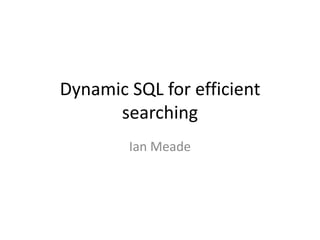Report
Share

Recommended
Recommended
More Related Content
Similar to Dynamic sql for efficient searching
Similar to Dynamic sql for efficient searching (20)
Чурюканов Вячеслав, “Code simple, but not simpler”

Чурюканов Вячеслав, “Code simple, but not simpler”
AppSphere 15 - Is the database affecting your critical business transactions?

AppSphere 15 - Is the database affecting your critical business transactions?
Designing, Building, and Maintaining Large Cubes using Lessons Learned

Designing, Building, and Maintaining Large Cubes using Lessons Learned
Performance Optimization of Cloud Based Applications by Peter Smith, ACL

Performance Optimization of Cloud Based Applications by Peter Smith, ACL
ECMDay2015 - Kent Agerlund – Configuration Manager 2012 – A Site Review

ECMDay2015 - Kent Agerlund – Configuration Manager 2012 – A Site Review
Roman Rehak: 24/7 Database Administration + Database Mail Unleashed

Roman Rehak: 24/7 Database Administration + Database Mail Unleashed
Scaling a High Traffic Web Application: Our Journey from Java to PHP

Scaling a High Traffic Web Application: Our Journey from Java to PHP
Dynamic sql for efficient searching
- 1. Dynamic SQL for efficient searching Ian Meade
- 2. Ian Meade • Working with databases and applications for 20 years. • Working with SQL Server since 2001 • Certifications: MCM for SQL 2008, MCITP, MCSD.NET
- 3. What is dynamic SQL • Dynamic doesn’t mean exciting or interesting, it simply means that the SQL queries are created at run time. • There are two main use cases for dynamic SQL. – DBAs to automate maintenance activates. – Used for complex and unpredictable queries
- 4. Why use dynamic SQL? • Can lead to incredible performance and scalability increases. – Reductions in query execution time, memory used, IO required – Lead to reductions in locking / blocking, flushing memory buffers and contention with other parts of work load. • Necessary as data sets grow to medium and larger sizes.
- 5. BUT…. • Dynamic SQL will not improve every type of query • Issues around: – more difficult to write and test and to change over time – security concerns that need to be resolved – memory issues – does not always fit easily into development frameworks like ORM tools
- 6. Scary? • Sounds like something to avoid? • Yes – you should avoid dynamic SQL where possible – Only use it where it can help. – Be careful with coding, testing and security.
- 7. Alternatives.. • Live with the problem – Suitable for smaller datasets and possibly batch operations • Hard code the query – Example • Push functionality down to the client • Hardcode parts of the query
- 8. Which queries to make dynamic • Customer search is a good example. • In most DBs, it usually has: – Large number of rows – Wide tables – Composed of several tables joined together – Unpredictable and complex search criteria • Could be other parts of the DB. – People / employees, Products other domain specific entities
- 9. Implementing dynamic SQL • Break query into parts • Assemble the required parts • Execute – Use sp_executesql to parameterise query • Security concerns • Example
- 10. Extending 1… • Make the search a re-usable function • Allows: – Re-use of search screen – Auditing by recording search results – Recording “as of” result sets – Extending search rules – eg security. • Example
- 11. Extending 2… • Making search meta-data driven • Re-using complex SQL “framework” • Suitable for applications with many similar search screens. • Example
